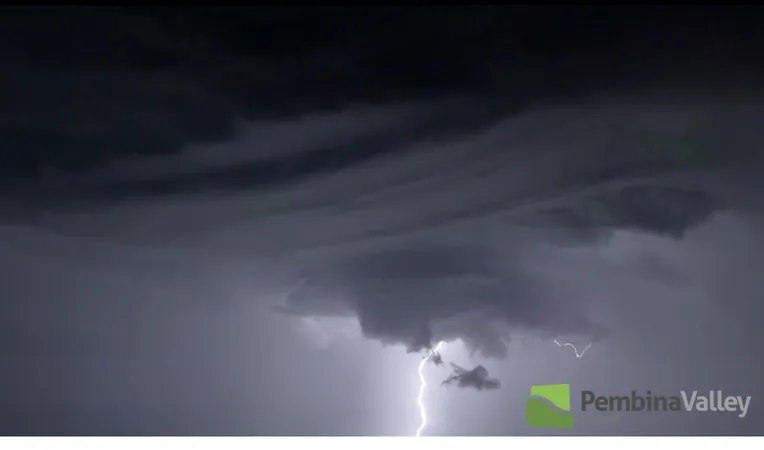
Astronomers Make Groundbreaking Discovery: First Direct Image of the Cosmic Web Revealed!
2025-06-30
Author: Benjamin
A Stunning Cosmic Discovery!
In an awe-inspiring leap for astronomy, scientists have captured the first-ever direct image of the elusive "cosmic web"—the invisible framework that binds galaxies together throughout the universe! But what exactly is this cosmic web, and why is it so crucial to our understanding of the cosmos?
Traditionally thought to be merely theoretical, the cosmic web comprises faint filaments of matter, so delicate that even our most advanced telescopes struggled to detect them. At last, recent observations have pulled one of these filaments into full view, shedding light on the hidden structure of our universe.
Unraveling the Cosmic Threads
The landmark discovery stems from observations of two ancient quasars—powerful sources of light—located over 11 billion light-years away. These quasars illuminate a faint yet significant bridge of hydrogen gas that connects them, which was painstakingly identified through hundreds of hours of telescope observation.
Led by an international team from the University of Milano-Bicocca and the Max Planck Institute for Astrophysics, the researchers harnessed the Multi-Unit Spectroscopic Explorer (MUSE) mounted on the European Southern Observatory’s Very Large Telescope in Chile. This sophisticated instrument allowed astronomers to distinguish the filament's weak hydrogen signature from the overwhelming cosmic noise.
A Glimpse into the Universe's Youth
This extraordinary image not only provides a glimpse into the distant past—capturing light that has traveled nearly 12 billion years—but it also confirms key predictions of cold dark matter theories. According to these theories, galaxies grow by siphoning gas through these intricate, web-like structures, rather than by merely absorbing isolated clumps of material.
The filament acts as a cosmic highway, delivering essential materials for future star formation and shaping the evolution of galaxies. The brightness of this filament gives scientists valuable insights into the distribution of dark matter, which is believed to make up about 85% of the universe’s total mass—yet remains largely invisible to conventional telescopes.
Data-Driven Insights into Cosmic Growth
Dr. Davide Tornotti, a key researcher in this groundbreaking study, expressed excitement over their findings, emphasizing how they were able to delineate the boundary between galactic gas and the material in the cosmic web. The team's meticulous efforts with MUSE gathered over 100 hours of data, allowing for an unprecedented level of detail in their imaging.
Their results demonstrated a striking correspondence between observed filaments and computer simulations, reinforcing our understanding of the underlying mechanics of the universe’s structure.
What’s Next for Cosmic Exploration?
Despite this monumental achievement, scientists are determined not to stop here. As Fabrizio Arrigoni Battaia, a scientist involved in the project, noted, this is just the beginning. The team is eager to gather more observations to unveil additional filament structures, aiming for a comprehensive map of how gas flows and distributes throughout the cosmic web.
The future of cosmic exploration looks even brighter with next-generation telescopes, such as the Extremely Large Telescope, which will enhance our ability to find more filaments and deepen our understanding of dark matter and galaxy evolution.
The Cosmic Web: Bridge to Galactic Birth?
The thread of gas connecting the two quasars isn't just a fascinating observation; it is a foundational aspect of how galaxies form and evolve. This newly documented filament not only illustrates the ongoing cosmic dance of gas but also sets a crucial benchmark for understanding galaxy formation processes across the universe.
As astronomers continue to discover more filaments, they will gradually reveal a clearer portrait of our universe’s invisible scaffolding, unlocking the secrets of both the structures and the dark matter that underpin them. Stay tuned as we venture further into this cosmic journey, one faint glow at a time!
This groundbreaking study is now published in the prestigious journal Nature Astronomy.









 Brasil (PT)
Brasil (PT)
 Canada (EN)
Canada (EN)
 Chile (ES)
Chile (ES)
 Česko (CS)
Česko (CS)
 대한민국 (KO)
대한민국 (KO)
 España (ES)
España (ES)
 France (FR)
France (FR)
 Hong Kong (EN)
Hong Kong (EN)
 Italia (IT)
Italia (IT)
 日本 (JA)
日本 (JA)
 Magyarország (HU)
Magyarország (HU)
 Norge (NO)
Norge (NO)
 Polska (PL)
Polska (PL)
 Schweiz (DE)
Schweiz (DE)
 Singapore (EN)
Singapore (EN)
 Sverige (SV)
Sverige (SV)
 Suomi (FI)
Suomi (FI)
 Türkiye (TR)
Türkiye (TR)
 الإمارات العربية المتحدة (AR)
الإمارات العربية المتحدة (AR)